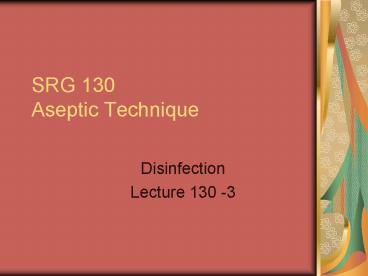SRG 130 Aseptic Technique - PowerPoint PPT Presentation
1 / 21
Title:
SRG 130 Aseptic Technique
Description:
... of nosocomial infection in the subsequent surgical patient ... Corrosive to surgical instruments, plastic and rubber, and lens. Can be used as an antiseptic ... – PowerPoint PPT presentation
Number of Views:85
Avg rating:3.0/5.0
Title: SRG 130 Aseptic Technique
1
SRG 130Aseptic Technique
- Disinfection
- Lecture 130 -3
2
S. Weir Mitchell
- He alone has lost the art to live who cannot win
new friends.
3
Text
- Surgical Technology Principles and Practices, 4th
Edition, Fuller, - Chapter 8
4
Objectives
- Trace the development of sterilization techniques
- Identify the principles and procedures related to
disinfection - Distinguish between disinfection and
sterilization - Analyze the factors and variables of disinfecting
agents - Contrast and compare disinfecting agents
5
Ancient Times
- The Bible- Moses
- Rome- Aristotle
- Middle Ages- Girolamo Fracastorius
- Contributions to the advancement of
sterilization- Surgical Technology for the
Surgical Technologist Chapter 7 Page 131
6
Disinfection
- Process by which most but not all pathogenic
microorganisms on inanimate surfaces are
destroyed - Suffix static refers to a process of controlling
or inhibiting growth - Bacteriostatic
- Suffix cidal means to destroy or kill
- Bactericidal
- Sporicidal
- Virucidal
- Germicidal
7
Goals of Terminal Disinfection
- Reduction in the bioburden created by surgical
intervention - Prevention of cross-contamination
- Prevention of nosocomial infection in the
subsequent surgical patient - Prevention of employee exposure
8
Process
- Confine
- Contain
- Reduce/eliminate
9
Classification of Patient-Care Equipment
- Category I Critical Items (High Level)
- Must be sterile
- Category II Semi critical Items (Intermediate
Level) - Come in contact with mucous membranes or skin
that is not intact - Category III Noncritical Items (Low Level)
- Come in contact with intact skin
10
Factors When Choosing a Disinfecting Agent
- Microbe resistance to chemicals
- Level of cidal action and their mechanism of
destruction - The nature of the microbe contamination
- Requirements of the cleaning agents vary
- Kill time
- Porosity of the surface/material
- Method of application
- Temperature
- Surface tension
11
Selection and Use of Disinfectants
- Most common is liquid disinfectant
- Selection is based on the result required
- Factors that affect a disinfectants activity
- Concentration
- Bioburden present- must clean and dry first
- Water hardness and pH
- Temperature of the solution
12
Precautions and Hazards
- Because of the toxicity of the disinfectant, the
following precautions always should be exercised - Store in well-ventilated rooms and their
containers kept covered - PPE
- MSDS
- Use measuring device and dilute correctly
- Do not mix
- Dispose of properly
13
Disinfectant Chemicals
- Alcohol
- Ethyl (grain) and isopropyl (rubbing)
- Water soluble
- Bactericidal, TB, virucidal, and HIV
- Optimum ability occurs at 60-70 dilution
- Corrosive to surgical instruments, plastic and
rubber, and lens - Can be used as an antiseptic
- Highly flammable and volatile
14
Halogens and Halogen Compounds
- Chlorine compounds
- Sodium Hypochlorite- Household bleach
- Broad-spectrum
- Limited in use because of corrosiveness to metals
- Deactivated in presence of bioburden
- Blood spills
- Do not mix
15
Halogen Compounds
- Iodophors/iodine-based compounds
- Oxidizes to kill TB, viruses, bacteria and fungi
- Corrosive to metal and stain fabrics
- Organic soils, hard water and heat inactivates
them - Should be replaced daily
16
Formaldehyde
- Formalin, 37 solution in water (8)
- Bactericidal, TB, fungicidal, virucidal, and
sporicidal - Preservation of tissue specimens
- Rarely used as high-level disinfectant agent
because of toxicity
17
Glutaraldehyde
- Cidex- 2
- Widely used high-level disinfectant
- Sporicidal, bactericidal, and virucidal
- Safe to use on instruments
- Requires prolonged exposure and rinsing x3
- Sterilant- 10 hours
- High level- 20 minutes
- All items must be dry and free from bioburden
prior to placement - 14 or 28 day shelf life with daily testing
- Must be used with a ventilation hood
18
Ortho-Phthaldehyde
- Cidex OPA (non-glutaraldehyde)
- High-level disinfectant
- 12 minutes
- Rinse 3 times with fresh water each time
- 14 day shelf life
- Test daily
19
Phenolics
- Carbolic acid in detergent form
- TB, fungicidal, virucidal, bactericidal
- Disinfectant for low-level only
- Follow directions for dilution
- Caustic to skin
- PPE
- Isopropyl alcohol neutralizes
20
Quaternary Ammonium Compounds
- Quats- benzalkonium chloride and dimethy benzyl
ammonium chloride - Fungicidal, bactericidal, and pseudomonacidal
- Sensitive to environmental conditions
- Not as an antiseptic
- Do not use with a sponge or gauze
21
Physical Means
- Boiling Water
- Ultraviolet irradiation































